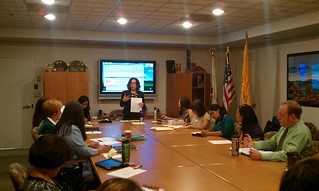 Some neighborhoods are more equipped to support active lifestyles than others.
Some neighborhoods are more equipped to support active lifestyles than others.
Resource Library
Wednesday, September 18, 2024 at 1 p.m. ET
Join us to learn about the fifth edition of Safe Routes Partnership’s state report cards and report, Making Strides: 2024 State Report Cards on Support for Walking, Bicycling, and Active Kids and Communities.
This report marks nearly a decade of work reviewing and scoring best practices in policy, funding and practices that support walking, biking, and active communities. We are excited to share the milestones and case studies that mark real progress during that time. During this webinar we will walk you through the scoring and indicators, the changes we have seen since our last state report cards in 2022, and how you can use this information to make change.
SPEAKERS:
- Kori Johnson, Program & Engagement Manager, Safe Routes Partnership
- Marisa Jones, Managing Director, Policy & Partnerships Director, Safe Routes Partnership
- Natasha Riveron, Policy & Implementation Manager, Safe Routes Partnership
Parks play a role in supporting public health, from mitigating the impacts of climate change to reducing depression and anxiety. A 2022 systematic review by the Community Preventative Services Task Force – part of the U.S. Department of Health and Human Services and supported by the Centers for Disease Control – emphasized the importance of Safe Routes to Parks for maximizing the health benefits of parks, greenways, and trails. The findings, published in what is called the Community Guide, showed that rates of physical activity improved significantly only when parks were combined with at least one of four key strategies to facilitate their access and usage: community engagement, public awareness, structured programming, and access enhancements. So, why does this matter? It reinforces that Safe Routes to Parks is a research-backed strategy for improving health outcomes. For more information on this research and related strategies, check out: Actionable Public Health Strategies to Boost Community Well-Being with Safe Routes to Parks.
 Those of us who have been in the field of bicycle and pedestrian advocacy for a while are quite familiar with the growing body of research connecting health to the built environment.
Those of us who have been in the field of bicycle and pedestrian advocacy for a while are quite familiar with the growing body of research connecting health to the built environment.
 In every county of Southern California, Pauline and I are witnessing a groundswell of support for Safe Routes to School. One of the key signs of this increasing interest is the creation of countywide coalitions formed around Safe Routes to School, healthy eating and active living.
In every county of Southern California, Pauline and I are witnessing a groundswell of support for Safe Routes to School. One of the key signs of this increasing interest is the creation of countywide coalitions formed around Safe Routes to School, healthy eating and active living.
 Change is inevitable, it is said. It is how we choose to adapt to this change that is central in the New York Times bestseller “Who Moved My Cheese?” that eloquently describes our instinctual response to change through a parable about two mice and two mini-people whose cheese supply has been moved.
Change is inevitable, it is said. It is how we choose to adapt to this change that is central in the New York Times bestseller “Who Moved My Cheese?” that eloquently describes our instinctual response to change through a parable about two mice and two mini-people whose cheese supply has been moved.
 The Florida Safe Routes to School program is lucky to have Sarita Taylor. While she may be new to the Florida Department of Transportation (FDOT) Safety Office in Tallahassee, she is not new to Safe Routes to School. She brings an impressive history from FDOT District 1.
The Florida Safe Routes to School program is lucky to have Sarita Taylor. While she may be new to the Florida Department of Transportation (FDOT) Safety Office in Tallahassee, she is not new to Safe Routes to School. She brings an impressive history from FDOT District 1.
 Another summer is behind us. My daughter is being reminded of what the world looks like at 7:00am as we implement a plan to get her back on a school schedule before the alarm clock rudely does its job on Tuesday, September 4.
Another summer is behind us. My daughter is being reminded of what the world looks like at 7:00am as we implement a plan to get her back on a school schedule before the alarm clock rudely does its job on Tuesday, September 4.
Muchas comunidades locales están ansiosas por utilizar fuentes de financiación del transporte para crear calles seguras para las personas que caminan y andan en bicicleta.
 This fall marks 20 years since I moved to California. I was born in Manhattan and grew up there and in New Jersey – learning important lessons about taking initiative and being direct - but I always had an eye toward the west and a fascination with the innovative ideas and policies that often originate in California and then go nationwide.
This fall marks 20 years since I moved to California. I was born in Manhattan and grew up there and in New Jersey – learning important lessons about taking initiative and being direct - but I always had an eye toward the west and a fascination with the innovative ideas and policies that often originate in California and then go nationwide.
 Co-authored with Kathy Cooke, network coordinator - One of the most common interests shared by staff at the Safe Routes Partnership is a love of books. Reading books, belonging to book clubs, haunting book stores when we're not working -- you name it.
Co-authored with Kathy Cooke, network coordinator - One of the most common interests shared by staff at the Safe Routes Partnership is a love of books. Reading books, belonging to book clubs, haunting book stores when we're not working -- you name it.
 October is my favorite time of year. Fall has finally arrived, as well as the state fair in the great state of Texas. One other huge reason I love the month of October is that Wednesday, October 3 is Walk and Bike to School Day.
October is my favorite time of year. Fall has finally arrived, as well as the state fair in the great state of Texas. One other huge reason I love the month of October is that Wednesday, October 3 is Walk and Bike to School Day.
En algunas comunidades, el peligro de la violencia y el crimen desanima a los niños de caminar a la escuela y la gente evita las calles, limitando sus actividades física y restringiendo sus mandados y viajes.
 Since it is now past October 1 and the MAP-21 transportation law is officially in effect, I was hoping to blog this month about the guidance from US Department of Transportation. Guidance provides additional information to the states about how to implement Transportation Alternat
Since it is now past October 1 and the MAP-21 transportation law is officially in effect, I was hoping to blog this month about the guidance from US Department of Transportation. Guidance provides additional information to the states about how to implement Transportation Alternat
WalkBoston and (MAPC) developed a tool for schools in Massachusetts to assess walking and biking potential. The tool reveals whether children living nearby are currently arriving in cars or whether most nearby students are already arriving on foot. A discussion of the tool can be found http://walkboston.org/what-we-do/initiatives/research.
 Today, the US Department of Transportation released its interim guidance, which provides states with additional information on how to implement the new transportation bill, MAP-21. Overall the guidance should be helpful to states and MPOs as they implement the bill and there is some good news in the guidance.
Today, the US Department of Transportation released its interim guidance, which provides states with additional information on how to implement the new transportation bill, MAP-21. Overall the guidance should be helpful to states and MPOs as they implement the bill and there is some good news in the guidance.
The Louisiana Department of Transportation Safe Routes to School program (LASRTS) will open the 7th cycle of funding January 2, 2013. Throughout the first six application cycles, LASRTS has funded 65 applicants; providing improvements to 88 schools around the state. Louisiana expects to fund more than $2 million in projects in the 2013 application cycle. Applications are due March 1, 2013.

A Special Invitation

